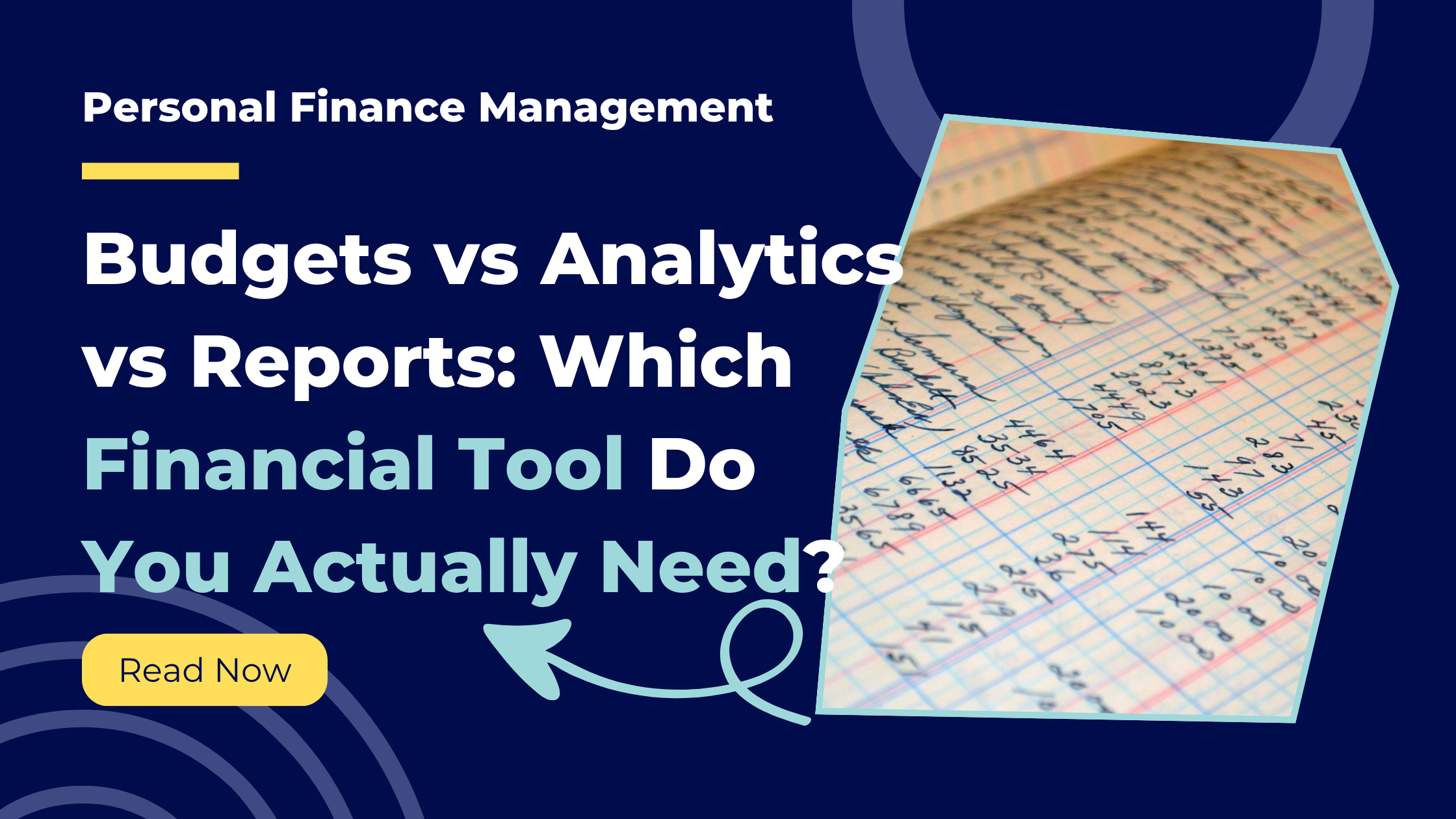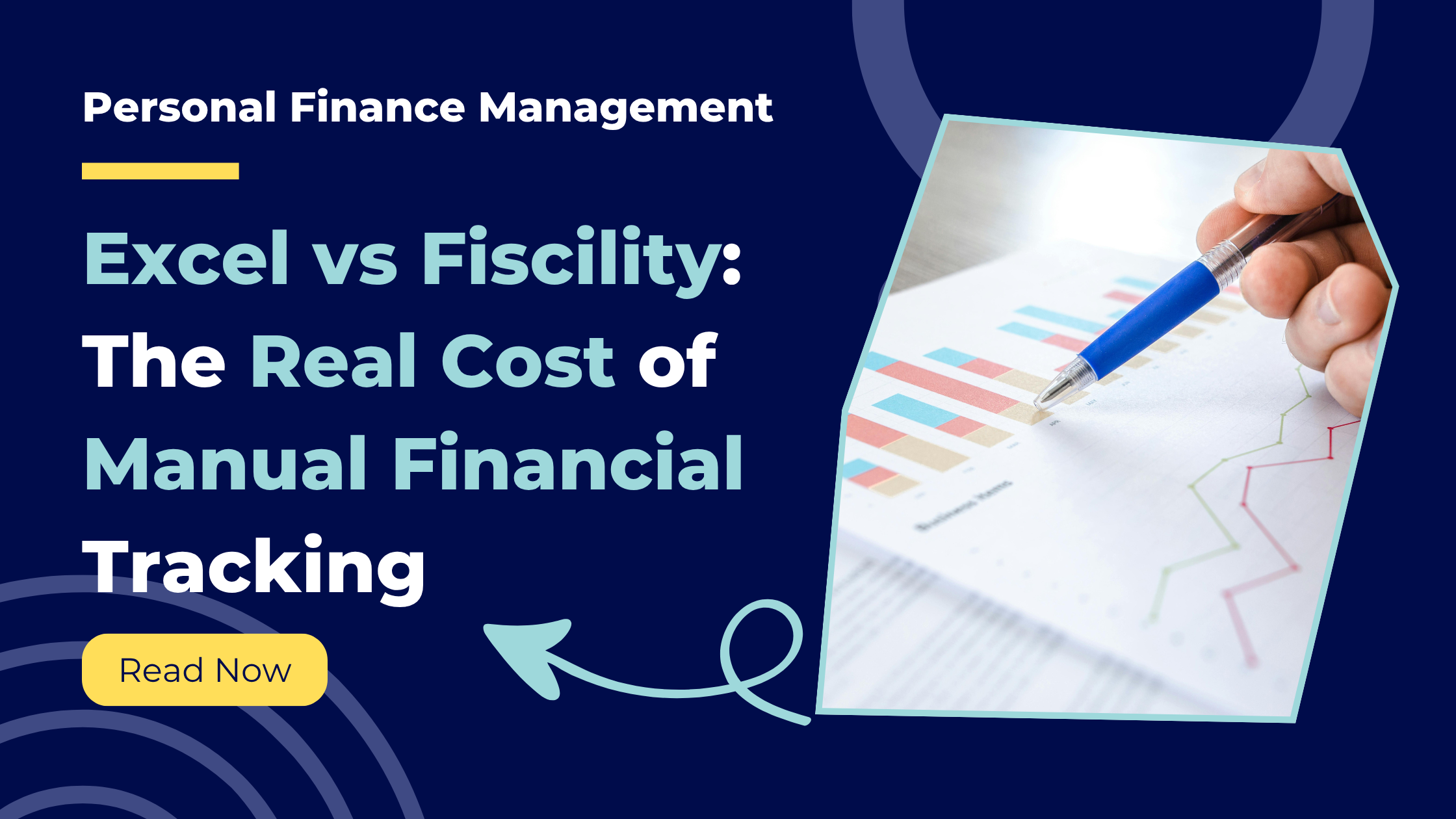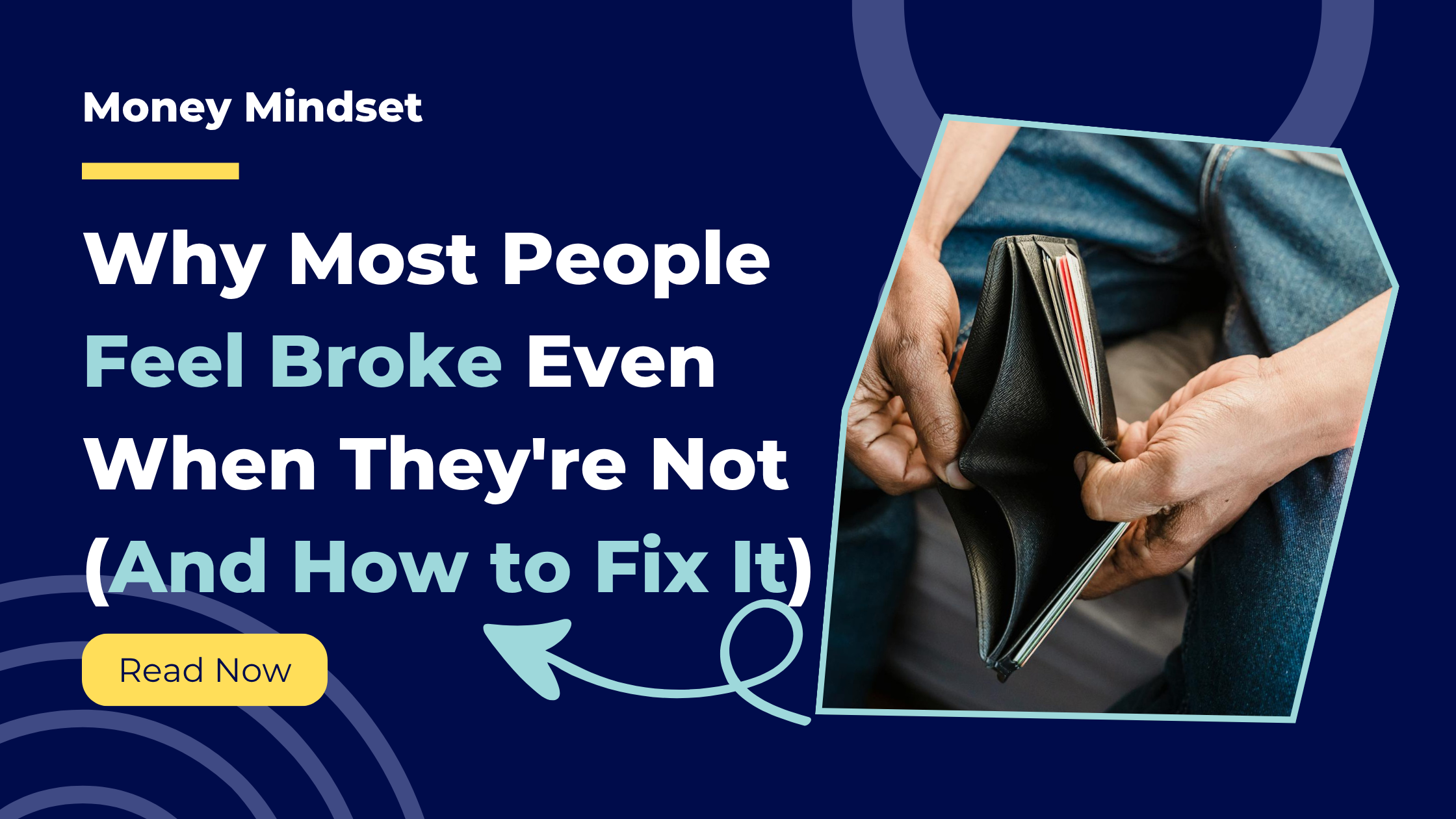
•
1 min read
Budgets vs Analytics vs Reports: Which Financial Tool Do You Actually Need?
Compare budgets, analytics dashboards, and scheduled reports to discover which financial approach matches your money management style and goals.
You have probably been told to create a budget. Track every category. Set limits. Stay disciplined. For some people, this works brilliantly. For others, it feels like homework that never ends.
The truth is that budgets are just one approach to financial clarity. There are two other tools that serve different purposes: analytics dashboards and scheduled reports. Each answers different questions about your money.
Budgets answer: "Am I staying within my limits?"
Analytics answer: "What patterns exist in my spending?"
Reports answer: "What is my current position and what should I do next?"
Most people think they need all three. Most people actually need only one or two. In this post, you will learn the strengths and limitations of each approach, when to use them, and which tool matches your financial situation and personality.
What Each Tool Actually Does
Budgets: Forward-Looking Limits
A budget is a spending plan. You allocate money to categories before the month begins. Groceries get £400. Petrol gets £120. Entertainment gets £80. Your job is to stay within those limits.
Budgets are prescriptive. They tell you what you should do. The system works when your life is predictable and your income is stable.
Analytics Dashboards: Pattern Recognition
An analytics dashboard shows you what happened. Total spending by category. Trends over time. Comparisons across weeks or months. Breakdowns by merchant or transaction type.
Analytics are descriptive. They reveal patterns. The system works when you need to understand your behaviour to make better decisions.
Scheduled Reports: Decision Context
A scheduled report delivers your current financial position at regular intervals. How much came in. How much went out. What is available now. What is coming next.
Reports are contextual. They inform immediate decisions. The system works when you need clarity on what you can safely do today without compromising tomorrow.
Budgets: The Prescriptive Approach
How Budgets Work
You start by reviewing past spending to estimate future needs. You assign every pound a job. Rent, groceries, transport, savings, discretionary. You track spending throughout the month to ensure you stay within limits.
If you overspend in one category, you adjust another. If you underspend, you reallocate or save the difference. The goal is control through planning.
Pros of Budgeting
Proactive spending control. Budgets stop problems before they start. If you allocate £400 to groceries and stick to it, you cannot accidentally overspend.
Forces intentionality. Creating a budget makes you confront your priorities. Where is your money going? Where should it go? This clarity alone improves financial behaviour.
Works well for debt repayment. When you need strict discipline to pay down debt or build savings, budgets provide structure and accountability.
Simple to understand. The concept is straightforward. Set limits. Track progress. Adjust as needed. No complex analysis required.
Cons of Budgeting
High maintenance effort. Budgets require constant monitoring. You must check spending against limits regularly, categorise transactions, and adjust allocations. This takes time and discipline.
Fails when life is irregular. If your income or expenses vary significantly month-to-month, static budgets break down. Freelancers, commission earners, and seasonal workers struggle with traditional budgeting.
Feels restrictive. For some people, budgets create stress rather than relief. Constantly checking limits and feeling guilty about small overages is mentally exhausting.
Backward-looking at review time. Budgets tell you if you stayed within limits after the fact. They do not always help you make real-time decisions about whether you can afford something today.
Category rigidity. Life does not fit neatly into budget categories. Do you categorise a restaurant meal as food or entertainment? Does petrol for a weekend trip count as transport or leisure? These ambiguities create friction.
Who Needs Budgets
Budgets work best for people who:
- Have stable, predictable income and expenses
- Struggle with overspending and need external guardrails
- Are actively paying down debt or saving for a specific goal
- Prefer structure and enjoy tracking systems
- Have the time and discipline to maintain detailed category tracking
If your financial life is variable, or if budgets feel like punishment, you need a different tool.
Analytics Dashboards: The Descriptive Approach
How Analytics Dashboards Work
An analytics dashboard aggregates your transaction data and presents it visually. You see total spending by category. You compare this month to last month. You identify trends. You spot anomalies.
Dashboards do not tell you what to spend. They show you what you did spend. The insight comes from pattern recognition, not prescription.
Pros of Analytics Dashboards
Reveals hidden patterns. You may not realise how much you spend on subscriptions or coffee until you see it visualised. Analytics surfaces these insights automatically.
Low maintenance. Once connected to your accounts, dashboards update automatically. No manual entry. No category assignment unless you want to refine it.
Flexible and exploratory. You can slice data by time period, category, merchant, or transaction type. You explore your spending from multiple angles without predefined limits.
Great for variable income. Analytics work regardless of income stability. You see what happened. You adjust behaviour based on reality, not a plan that no longer fits.
Less emotionally charged. Dashboards present facts without judgement. There is no guilt about exceeding a limit. You simply see the data and decide what it means.
Cons of Analytics Dashboards
No forward guidance. Dashboards show the past. They do not tell you what you can spend today or what is safe for the rest of the month.
Analysis paralysis. Too much data without context can overwhelm. You see trends but struggle to know what action to take.
Requires interpretation. Analytics demand financial literacy. You must understand what the patterns mean and how to respond. Not everyone has this skill or interest.
Reactive, not proactive. You learn about problems after they happen. If you overspend in week one, the dashboard will show it, but it will not prevent it.
Limited accountability. Without targets or limits, analytics lack built-in motivation. You can see you spent too much on takeaway, but nothing forces you to change.
Who Needs Analytics Dashboards
Analytics work best for people who:
- Want to understand their spending behaviour without rigid limits
- Have variable income or expenses that make budgeting impractical
- Enjoy exploring data and identifying patterns
- Prefer self-directed decision-making over external rules
- Are financially stable but want optimisation insights
If you need real-time decision support, analytics alone will not suffice.
Scheduled Reports: The Contextual Approach
How Scheduled Reports Work
A scheduled report delivers a snapshot of your financial position at set intervals. Daily, weekly, monthly, or all three. It shows current balances, recent activity, upcoming obligations, and available capacity.
Reports do not impose limits or dissect past behaviour. They answer one question: "What is my position right now, and what does that mean for my next decision?"
Pros of Scheduled Reports
Real-time decision support. Reports tell you what you can safely spend today without compromising future commitments. This eliminates guesswork.
Low cognitive load. You do not analyse trends or track categories. You receive context when you need it. Simple, actionable, immediate.
Builds consistency without effort. Scheduled delivery creates a rhythm. You review your position daily or weekly without remembering to check.
Works for all income types. Whether you earn a salary, freelance income, or commission, reports adapt. They show your current reality, not a plan.
Reduces financial anxiety. Knowing your position eliminates the mental maths and uncertainty that cause stress. You stop wondering. You know.
Forward and backward visibility. Good reports include recent activity and upcoming obligations. You see where you have been and where you are going.
Cons of Scheduled Reports
Less granular than analytics. Reports prioritise clarity over detail. You see totals and key metrics, but you may not get deep category breakdowns unless you seek them.
No built-in spending limits. Reports inform but do not restrict. If you need hard guardrails to prevent overspending, reports alone will not provide them.
Requires regular review. Reports only help if you read them. If you ignore your daily or weekly summaries, the system provides no value.
Relies on accurate data. Reports are only as good as the transaction sync. Delayed or missing data reduces accuracy and usefulness.
Who Needs Scheduled Reports
Reports work best for people who:
- Need to know what they can spend right now without constant manual checking
- Have multiple accounts and want consolidated visibility
- Prefer clarity over complexity
- Are comfortable with their overall spending but want confidence in daily decisions
- Value automation and low maintenance
If you need strict spending control or deep behavioural analysis, reports work best when combined with budgets or analytics.
Direct Comparison: When to Use Each Tool
Scenario-Based Recommendations
Scenario 1: Paying Down Debt
You need strict spending control and accountability. Every pound must be allocated intentionally.
Best tool: Budget (primary) + Scheduled Reports (secondary)
The budget provides guardrails. Reports confirm you are staying on track daily without manual checking.
Scenario 2: Freelancer with Variable Income
Your income fluctuates. Some months bring £5,000, others bring £2,000. Static budgets break.
Best tool: Analytics Dashboard (primary) + Scheduled Reports (secondary)
Analytics reveal spending trends over time. Reports show current runway and safe spending capacity based on actual balances.
Scenario 3: Financially Stable, Seeking Optimisation
You are not overspending, but you want insights. Where could you cut back? Where are you spending more than expected?
Best tool: Analytics Dashboard (primary)
You need pattern recognition, not limits or daily updates. Analytics surface opportunities for optimisation.
Scenario 4: Busy Professional Who Wants Clarity
You earn a stable salary but have multiple accounts and irregular expenses. You want to know your position without effort.
Best tool: Scheduled Reports (primary)
Reports consolidate accounts and deliver clarity automatically. No tracking. No analysis. Just context when you need it.
Scenario 5: First-Time Money Manager
You have never tracked finances before. You need structure and education about where your money goes.
Best tool: Budget (primary) + Analytics Dashboard (secondary)
The budget teaches intentionality. Analytics provide feedback on whether your allocations match reality.
How Fiscility Fits: Analytics + Scheduled Reports
What Fiscility Provides
Fiscility delivers two of the three tools: analytics dashboards and scheduled reports. It does not provide traditional budgeting with category limits.
This is intentional. Budgets work for some people, but they fail for many others. Fiscility focuses on clarity, not restriction.
The Analytics Dashboard
Fiscility consolidates all your accounts into one view. You see total balances, recent transactions, spending by category, and trends over time.
The dashboard updates automatically. You can explore spending patterns, compare time periods, and identify anomalies. No manual categorisation required unless you want to refine it.
This is pattern recognition without prescription. You see what is happening. You decide what it means.
The Scheduled Reports
Fiscility delivers daily, weekly, and monthly reports via email or in-app notifications. Each report includes:
- Current balances across all accounts
- Recent activity summary
- Upcoming obligations and recurring expenses
- Available discretionary spending capacity
- Cashflow trends
You choose the frequency. The system does the rest.
Reports answer the most important question: "What can I safely spend today?"
Why Fiscility Does Not Do Budgets
Budgets assume your financial life fits into predefined categories and limits. For many people, this assumption is false.
Freelancers, commission earners, and people with irregular expenses cannot maintain static budgets. Even those with stable income often find budgets feel restrictive and high-maintenance.
Fiscility prioritises flexibility and clarity over control. If you need strict category limits, traditional budgeting apps like YNAB or Goodbudget may suit you better. If you need insight and decision confidence, Fiscility delivers that without the overhead.
Combining Tools Outside Fiscility
You can use Fiscility alongside a budgeting app if you need both approaches. Fiscility handles visibility and reporting. Your budgeting app handles limits and accountability.
This combination works well for people paying down debt who also want automated clarity.
Key Takeaways
Budgets, analytics, and reports serve different purposes. Most people need only one or two, not all three.
Budgets work when you need strict spending control and have predictable income. They are high-maintenance but provide accountability.
Analytics work when you need to understand spending patterns without rigid limits. They are low-maintenance but require interpretation.
Reports work when you need real-time decision confidence with minimal effort. They provide context without restriction or deep analysis.
Your financial situation and personality determine which tool fits best. Debt repayment needs budgets. Variable income needs analytics and reports. Busy professionals need reports.
Fiscility delivers analytics dashboards and scheduled reports, focusing on clarity and decision confidence rather than restrictive category limits.
Which Tool Do You Need?
Ask yourself three questions:
Do I struggle with overspending and need hard limits?
If yes, you need a budget.
Do I want to understand my spending patterns and optimise over time?
If yes, you need analytics.
Do I want to know what I can safely spend today without manual checking?
If yes, you need scheduled reports.
Most people benefit from combining two tools. Budgets + reports for debt repayment. Analytics + reports for variable income. Analytics alone for optimisation.
Fiscility provides analytics and scheduled reports, giving you clarity and confidence without the overhead of traditional budgeting.
Try Fiscility free for 7 days and discover how automated analytics and scheduled reports eliminate financial guesswork: Start Your Free Trial
Summary
The right financial tool depends on what you need to know and how your financial life operates.
Budgets provide control through limits. Analytics provide insight through patterns. Reports provide confidence through context.
No single approach works for everyone. Most people need one or two tools, not all three.
Fiscility focuses on what most people actually need: visibility, clarity, and decision confidence through automated analytics and scheduled reporting.
Found this helpful? Share it with others!
Ready to take control of your finances?
Join Fiscility today and start your financial journey.
Apply for a Membership

